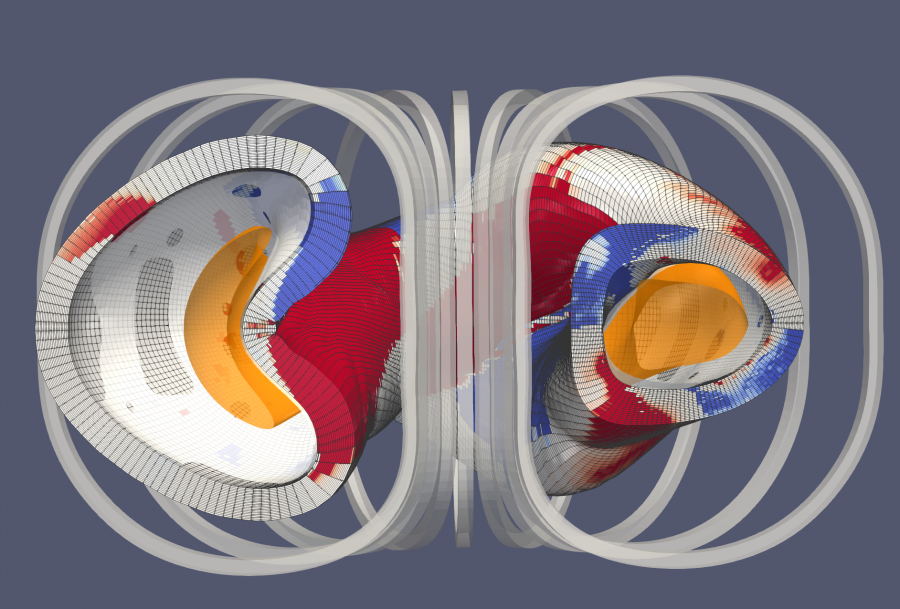Mar 12 2020
Fusion energy could be rapidly developed using permanent magnets that are similar to those utilized on refrigerators. Fusion energy is the same kind of energy generated by the stars and sun.
 Schematic image of permanent magnet stellarator with plasma in yellow. Red and blue indicate permanent magnets with simplified coils surrounding the vessel. Image Credit: Coaxing Zhu.
Schematic image of permanent magnet stellarator with plasma in yellow. Red and blue indicate permanent magnets with simplified coils surrounding the vessel. Image Credit: Coaxing Zhu.
Researchers at the Max Planck Institute for Plasma Physics in Greifswald, Germany and the U.S. Department of Energy’s (DOE) Princeton Plasma Physics Laboratory (PPPL) believe that theoretically permanent magnets can considerably streamline the design and production of twisty fusion facilities known as stellarators. The stellarator was invented by PPPL founder Lyman Spitzer Jr. in the early 1950s.
A majority of stellarators utilize a series of intricate and twisted coils that spiral just like stripes seen on a candy cane to create magnetic fields. These magnetic fields mold and regulate the plasma that drives fusion reactions.
According to the researchers, permanent magnets like those used on refrigerators could create the hard part of these essential magnetic fields, enabling simple and non-twisted coils to create the remaining part instead of the complex coils.
Twisted Coils Most Expensive
The twisted coils are the most expensive and complicated part of the stellarator and have to be manufactured to very great precision in a very complicated form. We are trying to ease the requirement on the coils by using permanent magnets.
Per Helander, Study Lead Author and Physicist, Max Planck Institute for Plasma Physics
Helander is also the head of the Stellarator Theory Division at Max Planck Institute for Plasma Physics.
Simplification of stellarators, which work without the danger of damaging disruptions often faced by more extensively utilized tokamak fusion devices, can be highly appealing.
I am extremely excited about the use of permanent magnets to shape the plasma in stellarators. It leads to much simpler engineering design.
Steve Cowley, Study Coauthor and Director, Princeton Plasma Physics Laboratory
Fusion can be defined as the energy that powers the stars and sun. It integrates light elements in the form of plasma that produces large amounts of energy. Plasma is the hot and charged state of matter made up of atomic nuclei and free electrons.
Globally, researchers are utilizing stellarators, tokamaks, and other similar facilities in an attempt to produce and manage fusion on Earth for an almost unlimited supply of clean and safe power to produce electricity.
The innovative concept for permanent magnets is part of a science fair project that Jonathan Zarnstorff put together in junior high school. Jonathan Zarnstorff is the son of PPPL Chief Scientist Michael Zarnstorff, who is also the study’s coauthor.
Jonathan wished to develop a rail gun, a kind of device that often utilizes high-voltage current to produce a magnetic field. This field is capable of firing a projectile. However, the high-voltage current would be too risky to utilize in a classroom setting.
Father and Son Solution
Father and son decided to use rare earth, permanent, or neodymium magnets to create the magnetic field without any hazards. Rare earth magnets are known to have useful and unexpected properties and produce extremely strong fields for the tiny size of the magnets. These are “hard” fields that are virtually unaffected by other nearby fields.
Such magnets could, therefore, offer what researchers call the “poloidal” portion of a spiraling stellarator field, whereas simple round coils could potentially offer the “toroidal” portion that constitutes the rest of the magnetic field.
The idea eventually came to fruition during debates with Cowley and Cary Forest, a physicist from the University of Wisconsin-Madison.
Permanent magnets are constantly “on” in vivid contrast to the typical electromagnetic coils used by tokamaks and stellarators. These electromagnetic coils produce magnetic fields when electricity passes through them—electricity that needs power supplies that otherwise are not required by permanent magnets. Other benefits of the application of permanent magnets to streamline stellarator coils include:
- Decreased engineering and manufacturing risks
- Potential to reposition the magnets to produce a wide range of shapes for the magnetic fields
- Generation of sufficient space between the simplified coils to ease maintenance
- Lower cost when compared to hand-crafted electromagnets
But permanent magnets also have drawbacks.
“You can’t turn them off,” added Helander, which implies that permanent magnets can pull in anything they can attract within their range. These magnets can even create limited maximum field strength, he stated.
Nevertheless, permanent magnets “can be great for creating experiments on the way to a reactor,” added Helander, “and stronger permanent magnets may become available.”
New Set of Tools
According to Zarnstorff, permanent magnets are “a strategy and a new set of tools, and we have to figure out how to use them.” He is currently planning a number of applications for these magnets. First will be the development of a table-top stellarator in which permanent magnets are set up.
Next, Zarnstorff believes that PPPL could possibly create the first-ever simple optimized stellarator, one developed to fulfill certain performance goals.
That facility can possibly be improved to boost its field strength, in preparation for the sustained development of the simplified machine. Ultimately, a stellarator equipped with permanent magnets could generate energy to produce electricity for the whole of mankind.
The study’s coauthors include physicist Michael Drevlak from the Max Planck Stellarator Theory Division, who performed the numerical optimization. The study was supported by the Simons Foundation, the DOE Office of Science (FES), and the Max Planck Society.